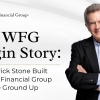Nespresso doesn’t just sell coffee.
In the brand’s new ad campaign, George Clooney sips the product on the terrace of a palatial European villa.
The company called in famed French architect Francis Krempp to design its worldwide stable of luxury coffee boutiques where customers are treated like five-star hotel guests.
And sports-car creatives at Porsche were recruited to help design the brand’s signature coffee machine.
All this seems like a lot of trouble to go to sell a cup of coffee. But Nespresso, like most successful big brands, is selling much more than that.
From Nespresso to Louis Vuitton to Nike, the world’s most successful consumer brands offer something intangible along with the physical products they sell. They make a connection beyond your rational assessment of the object they’re selling.
They achieve this through offering an aspirational brand experience that is consistently expressed through every consumer touch point — from the advertising campaign to the retail experience to the way the product feels in your hands.
That’s all well and good, but what does it have to do with the three-bedroom family home in the suburbs you’re currently trying to sell?
Everything.
Just as Nespresso’s marketing campaign is as much about image and lifestyle as it is about coffee, your approach as a Realtor is about more than bricks and mortar.
The humble property listing is a key opportunity to flex your branding muscles. Too often overlooked by busy Realtors, many property listings have become a bare-bones list of bullet points haphazardly thrown together between phone calls.
But given the appropriate attention, the words in your listing offer an opportunity to leverage the property photography and link it to your target market’s lifestyle aspirations to create a bona fide brand.
Here are three lessons you can learn from big-brand marketing:
1. Build a brand personality.
Your listings should use mood and tone to create a brand personality for your property that speaks to the aspirations of your target market beyond the standard features of the home — just like Rolex offers more than a watch, Coca-Cola presents a lifestyle image beyond the sugary soft drink in the can, and buying an Apple computer is seen by enthusiasts as a statement about creativity.
Ask yourself: What are the lifestyle aspirations of your target market? What image do they want to portray to their friends and colleagues? And how does the property at hand fulfill these?
Use your listings to make these connections for the buyer. Done well, this can encourage the buyer to feel a sense of ownership over the property before they’ve ever inspected it in person — and may even help to boost the value of the home beyond the sum of its parts.
2. Create an emotional connection.
Good real estate copywriting builds on the value of your photography by linking the images together to provide a “walk-through” experience for potential buyers.
Think of the copy in your listing as the tour guide. Building context around the photos, floor plan and video footage helps create a clear vision of the property in the buyer’s mind.
Your copy should take readers on a logical tour of the property to help activate the imaginations of your readers. Rather than a simple list of features, a walk-through narrative will encourage your reader to picture themselves inside the property and help create an emotional connection over and above a rational one.
3. Unlock the power of potential.
Rather than simply pointing out property features in your listings, take the extra step and link them to a lifestyle benefit.
Too many property listings trumpet the “potential” of a home without getting specific about what that potential looks like, and how it impacts the day-to-day lifestyle of the buyer.
Indeed, “potential” is about far more than the possibility of renovation. An effective property listing places the buyer’s focus on how they will use the home, and how this particular property will deliver the lifestyle they are seeking.
After all, sales is essentially a lifestyle game. Most big brands don’t just sell a product; they also sell an experience, aspiration or statement. So should you.
For more copywriting tips, download Shane Conroy’s free e-book, “The Complete Guide to Writing: Property Listings.”
Shane Conroy is the founder of Real Estate Copywriting Online.
The post 3 things Realtors can learn from big-brand marketing appeared first on WFG National Title Insurance Company.






